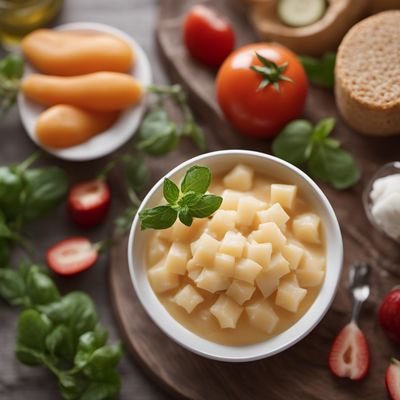
Ingredient
Food for infants and young children
Nourishing Meals for Little Ones
Food for infants and young children is carefully crafted to provide the necessary nutrients for optimal growth and development. These foods are often pureed or mashed to make them easier for babies to consume. They come in a variety of flavors and textures, offering a range of options to introduce new tastes and textures to young palates. It is important to choose age-appropriate foods that are free from additives, preservatives, and excessive sugar or salt.
Origins and history
The concept of specialized food for infants and young children has been around for centuries, with different cultures developing their own traditional recipes and feeding practices. In modern times, the production and availability of commercial baby food have made it easier for parents to provide their little ones with a balanced and convenient diet. The nutritional needs of infants and young children are constantly evolving, and ongoing research and advancements in food science continue to shape the development of these specialized foods.
Nutritional information
Food for infants and young children is formulated to provide essential nutrients such as protein, carbohydrates, healthy fats, vitamins, and minerals. These foods are often fortified with iron, calcium, and other micronutrients to support healthy growth and development. It is important to read the labels and choose products that are free from artificial additives, excessive sugar, and salt. Consulting with a pediatrician or registered dietitian can help ensure that the chosen foods meet the specific nutritional needs of the child.
How to select
When selecting food for infants and young children, it is important to choose age-appropriate options that are suitable for the child's developmental stage. Look for products that are labeled as suitable for the child's age range and follow the recommended guidelines for introducing new foods. Opt for products that are free from artificial additives, preservatives, and excessive sugar or salt. Fresh, homemade baby food can also be prepared using age-appropriate ingredients and following proper food safety guidelines.
Storage recommendations
Food for infants and young children should be stored according to the manufacturer's instructions. Most commercially available baby food comes in sealed jars or pouches that can be stored at room temperature until opened. Once opened, any unused portion should be refrigerated and consumed within a certain timeframe to ensure freshness and safety. Homemade baby food should be stored in airtight containers in the refrigerator and used within a few days or frozen for longer-term storage.
Preparation tips
Preparing food for infants and young children requires careful attention to hygiene and food safety. Wash hands thoroughly before handling any ingredients and ensure that all utensils and equipment are clean. Follow age-appropriate recipes and guidelines for introducing new foods and textures. Puree or mash foods to an appropriate consistency for the child's developmental stage, gradually introducing more textures as they grow. Avoid adding salt, sugar, or honey to the child's food, as their bodies are not yet equipped to handle these ingredients. Always supervise children while they are eating to prevent choking hazards.
Culinary uses
Food for infants and young children is commonly used to introduce new flavors and textures to their developing palates. Pureed fruits and vegetables, mashed grains, and soft proteins are often the first foods introduced. As the child grows, a wider variety of ingredients and textures can be incorporated into their meals, including finely chopped or shredded foods. These foods can be served as standalone meals or combined to create more complex dishes. It is important to follow age-appropriate guidelines and consult with a pediatrician or registered dietitian for personalized recommendations.
Availability
Food for infants and young children is commonly available in most countries, as it is an essential component of early childhood nutrition. Commercial baby food products can be found in grocery stores, supermarkets, and pharmacies. Homemade baby food can be prepared using fresh ingredients that are readily available in local markets or grown in home gardens.
More ingredients from this category

Infant and follow-on formulae
Nourishing Liquid Gold

Ready-to-eat meal for infants and young children
Nourishing Delights for Little Ones: Ready-to-Eat Meals for Infants and Young Children

Processed cereal-based food for infants and young children
Nourishing Starters: Exploring Cereal-based Foods for Little Ones